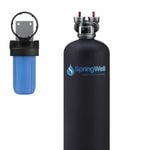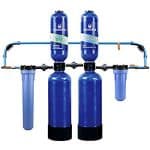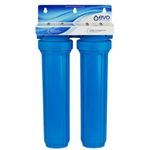We understand how difficult it can be to find the right whole-home water filtration system and that’s why we carefully evaluated each filter based on its performance, ease of installation and maintenance, and affordability.
Our goals are to keep user experience in mind and would only consider systems we found in our research and testing that were both reliable and simple to operate. That’s why we’re confident that the filters we’ve chosen will provide you with the best bang for your buck.
We’re here to help you make the most of your water filtration system and to make sure you get the clean water you deserve.
#1 is my favorite, but #2 and #9 are best overall for the money…
Expert Picks:
- Best for City/Town Tap Water: SpringWell CF
- Runner-up: Aquasana EQ-1000
- Best for Well Water: SpringWell WS
- Runner-up: Home Master 3-Stage System
- Best Budget for Municipal Water: Pentair PC600
- Best Cartridge Filter: Kind-1000
#1. SpringWell Whole House Water Filter System – Best Buy In 2024
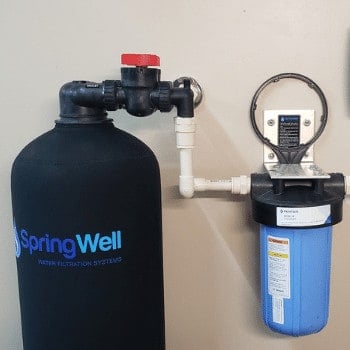
Are you tired of that disgusting chlorine smell? Or that gross after taste of chemically treated city water.
Let me tell you that you’re not alone and this whole house water filter system is what you need – it’s as close to spring water as it gets.
Features
- Eliminates 99.6% of germs contained in tap water
- Targets: Chlorine, Chloramine, PFOA, PFAS PFOS and more
- Highest quality catalytic carbon and certified kdf filter media
- Backed by a 6-month money back guarantee
- Industry leading (GPM)
- Easy installation & low maintenance
Use Coupon Code: QWL5 to Save!
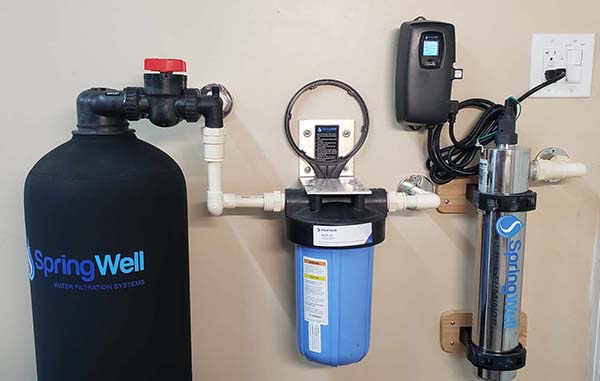
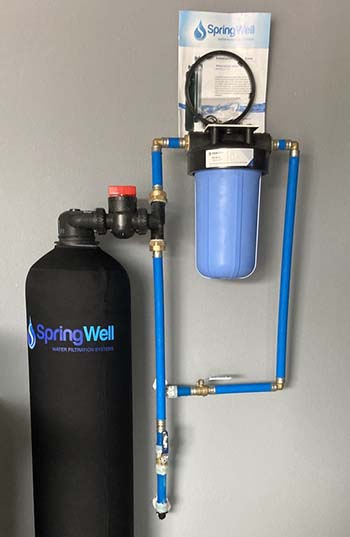
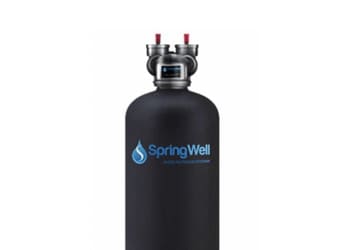
Best for: This system is for those looking for the best overall value in a whole home water filtration system that’s simple to use with the least amount of maintenance and annual costs.
Not best for: Homeowners that get their water from a well with high levels of Iron, Manganese and Sulfur – we would suggest Springwell’s WS system to handle those issues.
Pros
- In our testing, we found that you’re getting the best of the best in filtration that’s easy to operate – No other filtration system comes close!
- There’s no changes in water-pressure, no residue on your faucet fixtures, low annual cost to operate, no itchy dry skin feeling after you take a shower, and best of all — fresh, crisp tasting water.
- Springwell also carries a 4.7+ positive rating with thousands of positive reviews and I haven’t seen such quality priced this good.
- We really enjoy the simplicity of operating the Springwell CF1 and if you’re handy DIY’er – you can have the CF1 installed in less than 4 hours.
- SpringWell CF uses the highest grade certified filtration media available by using a catalytic carbon coconut shell + KDF to tackle contaminants such as PFOS, PFOA, heavy metals, pesticides, herbicides, chloramine, and chlorine.
- The CF utilizes 4-stages to filter your tap water: sediment filter, KDF, coconut shell carbon media and the last stage eliminates channeling allowing your water to have more contact with the filtration process.
- This system comes equipped with a 5-micron filter to handle the toughest of sediment.
- The SpringWell CF whole house water filter line comes in three sizes: 1-3 baths, 4-6 baths, and 7+ bathrooms allowing to save money by not overpaying for what you DON’T need.
- Low annual cost of $40 annually in replacement sediment filters.
Cons
- I wish the clack connectors were included for a faster DIY install.
What Others Have Said
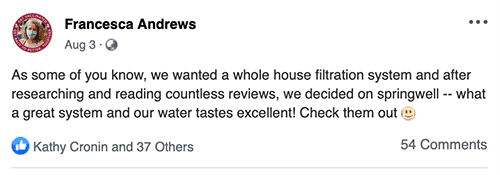
SpringWell CF Product Updates:
- Springwell now offers “clack connectors” for an easy DIY installation without the use of additional pipe fittings and elbows.
Use Coupon Code: QWL5 to Save!
Read our Full Review: Springwell Whole House Filter Review
#2. Kind E-1000 Whole House Water Filter – Best Cartridge Filter
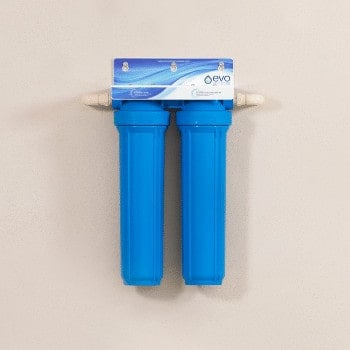
If the taste and smell of Chlorinated city/tap water has you feeling down and you’re looking for a low-cost city water filter system.
I have good news for you, the Kind-1000 whole house water filter will solve those problems.
Features
- Catalytic carbon filter media
- Washable sediment Pre-filter
- No loss in water pressure
- 120-day money back guarantee
- High Gallons per Minute rating (GPM)
- Low cost filtration system
- No pre-soak required
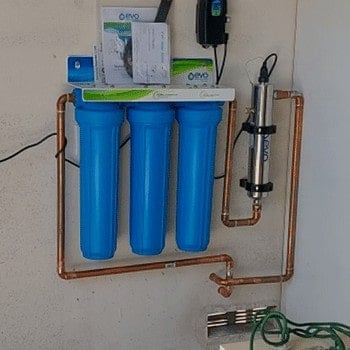
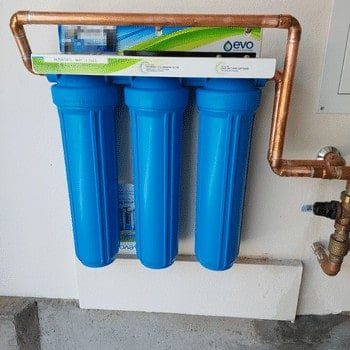
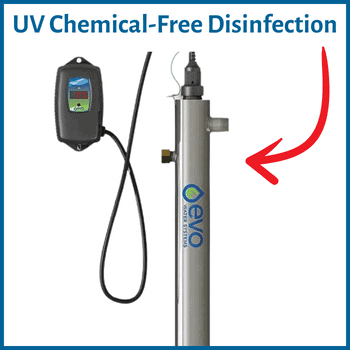
Best for: If you’re looking for a low-cost whole house cartridge filtration system for your home that can hang with the big named brands like Ispring or home master.
Not best for: If you’re looking to remove Fluoride from your tap water, this system isn’t going to do it. A reverse osmosis system would be your best choice in this case.
Pros
- In our research, we’ve found that Kind, like Springwell will eliminate the awful smell of chlorine and remove nasty chemicals all while NOT affecting your water pressure one bit.
- We like that this whole house water filter system is affordable and that you can save money with their washable sediment pre-filters — a big money saver right there.
- Evo can easily be installed by a DIY’er and filter changes take less than 10 minutes.
- The Kind 1000 is great for reducing over 100 contaminants in your water supply.
- This 15 GPM system can handle up to 6 bathrooms without any loss in water pressure.
- The Kind-1000 can be installed outside or inside (36 – 120 temps)
- This system comes ready to install with everything you need. Filter housing, carbon & sediment filter, spanner wrench for quick filter changes and a wall mounting bracket with plumbing reducers.
- This is the best budget whole house water filter system on the market.
Cons
- There’s not a lot of information on their website in regards to how they test their filters.
- I would like to see at least 100,000 gallons filtered to reduce frequent filter changes.
What other buyers have said:
EVO Filter Product Updates
- For those with hard water issues, Kind now offers the Kind-3000 combo filtration system that’s also salt-free.
- Now offers “auto-ship” so you don’t need to worry about ordering replacement filters when changes are needed.
Read our full review: Kind-E 1000 Whole house water filter review
#3. Aquasana EQ-1000 Whole House Water Filter System – Best Overall
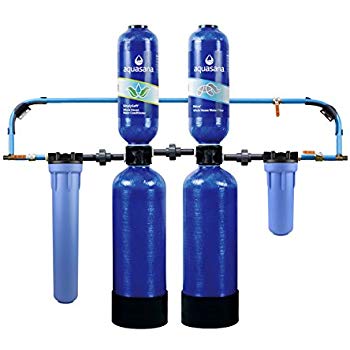
Typical water filters don’t remove hard minerals — that requires a water softener.
Aquasana’s EQ-1000 solves that problem with Simplysoft — a unique salt-free descaling system that filters and softens your water without removing beneficial minerals.
Features
- Eliminates the need for a water softener in most cases
- Improved flow-rate
- Fresh tasting water
- Softer hair & Skin
- 90 days to test out
- NSF Certified
Use Coupon Code: AQQWL50 to Save!

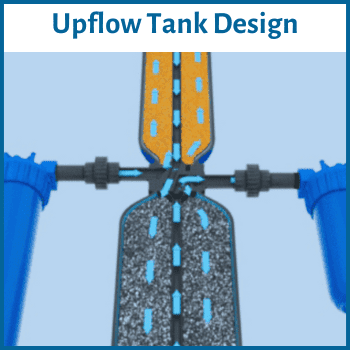
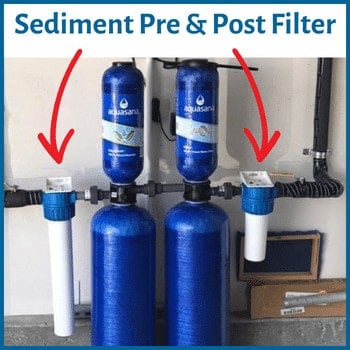
Best for: This system is best for those looking for a 2-in1 solution for both water filtration and hard water. If you have heavy limescale, I would lean towards Aquasana to solve your needs.
Not best for: If you’re looking to filter out harmful PFOA and PFOS or lower total dissolved solids (TDS, this system won’t do it for you. I would recommend Springwell CF1 to tackle this for you.
Pros
- If you’re sick of dealing with dry skin and hair, or having to scrub limescale off of your appliances more often than not, this is what you need.
- We like the fact that this is a top rated all-in-one whole home system that just takes care of it all and last for 10 years without us having to think about swapping out the tanks.
- The EQ-1000 has over 800+ positive reviews and a 4.6 star rating.
- The Pre & Post filter give you ultimate protection from sediment and organic materials before you ever pour a glass of water.
- This 12 GPM system can handle up to 3 bathrooms
- Bacteriostatic media stops bacteria from growing inside of your tank
- NSF 42 tested to remove 97.1% of Chlorine.
- The upflow tank design elminates channeling and blockage.
- Increased water contact time to remove contaminants efficiently from the filter media
- This whole house water filter system is designed for quick tank changes.
- This is an overall low maintenance system that anyone can run with peace of mind.
Cons
- Limited one-year warranty for DIY installation
- Additional tubing must be purchased by the customer
- Higher than average filter replacement cost
What others have said:
Aquasana EQ Product Updates:
- Aquasana now offers a Pro-grade installation kit that comes with stronger fittings and piping.
- Optional UV (ultra-voilet light) addon that can neutralize nearly 100% of harmful viruses lurking in your water.
Read our Full Review: Aquasana EQ-1000 Review
#4 Pentair PC600 Whole House Water Filter
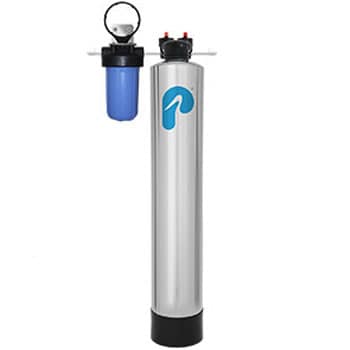
If your municipal water tastes like it came from a swimming pool, but you’ve given up on water filtration because it’s a hassle, you’re going to love the Pentair’s whole house water filter system.
- Removes 97-percent of chlorine
- NSF/ANSI Standards 42 and 61 certified
- Steel-wrapped tank
- Won’t reduce water pressure
- 90-day satisfaction guarantee
- Fresh & odorless water
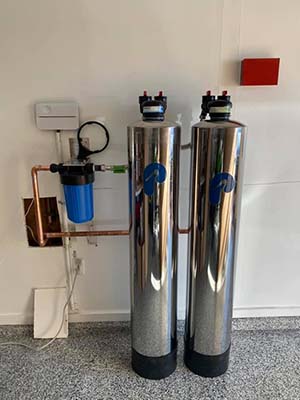
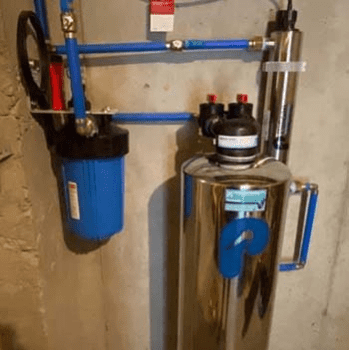

Best for: This system primary targets Chlorine and does so very well as well as other contaminants found in tap water — giving you fresh odorless drinking water
Not best for: If you have well water containing Iron, don’t waste your time on this system as it can’t remove Iron.
Pros
- Carbon block filters work well for a broad range of contaminants, but they’re small and need frequent changing.
- If you love your Brita pitcher or under-sink carbon block filter, think of the Pentair as the same thing with better performance and without the annoying maintenance.
- With its advanced granular activated carbon media it can filter 600,000 gallons of water.
- A 5-micron sediment filter removes suspended particles while bacteriostatic KFD 55 media prevents the growth of bacteria and algae, so you know what you’re drinking is pure.
- The 5-micron pre filter tackles fine to heavy sediment with ease.
- Coconut shell carbon filter eliminates common city water contaminants.
- Low annual cost system to run.
- On demand water regeneration process.
- Reduces odors and chlorine
- Multiple sizes for all types of home requirements
- Doesn’t require electricity to run
Cons
- Carbon media requires a 48-hour soak before use
Pentair PC600 Product Updates:
- Improved Bypass valve fittings
#5. iSpring WGB32B 3-Stage Whole House Water Filtration System
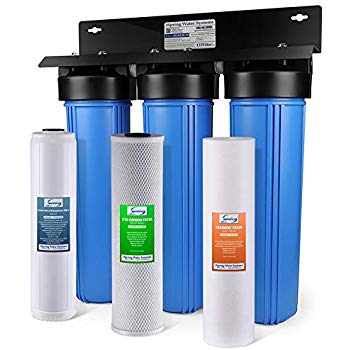
This iSpring 3-stage whole house filter is equipped with a three-stage gradient filtration system that maximizes filter life.
This system is great for tackling chlorine.
Features
- 99% of Chlorine removed
- Minimal water pressure reduction
- Easy to install
- Fresh tasting water
- NSF certified parts
- 30-day satisfaction guarantee
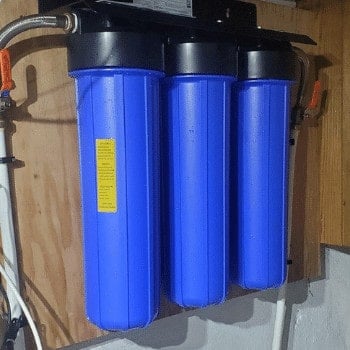
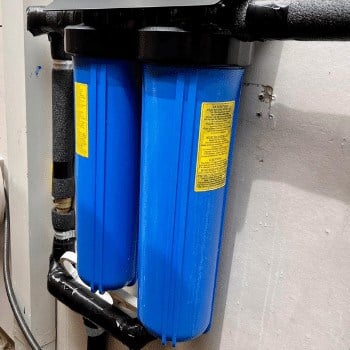
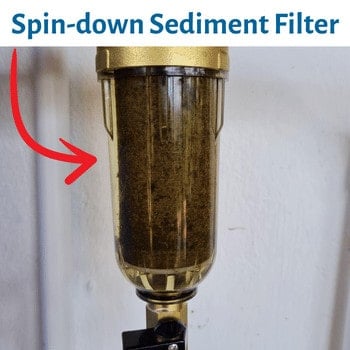
Best for: Those looking to get rid of that look of brown water or that look of rust in your sinks, toilets and tubs. This is a low-cost solution.
Pros
- A fine sediment cartridge removes dirt, dust, silt and rust while two high-density coconut carbon filters reduce 95-percent of chlorine, heavy metals, volatile organic compounds (VOCs) and other chemical contaminants.
- For treating city water, the iSpring’s advanced carbon block technology removes 95-percent of the contaminants I’m most worried about — especially lead — without the high cost of neutralizing pathogens.
- Healthy minerals are left in, and the water tastes fantastic.
- Other whole house water filter systems are a bit easier to maintain, and I’d feel better if the warranty was longer.
- We like the 100,000-gallon filter capacity and brisk water flow.
- Ispring’s 3-stage multi filter reduces clogging that doesn’t compromise water pressure in doing so.
- Reduces odors, cloudiness and chlorine effectively
- Eliminates stains on appliances
- Literally no waste water
Cons
- Replacing water filters frequently can get costly
Additional Features
- Sediment filter has a 5 micron rating which is ideal for most sediment issues.
- Coconut shell-based carbon eliminates odors and chlorine.
- Easy replacement filter change out.
Ispring 3-stage Product Updates:
- Ispring now comes with CTO carbon block filters for enhanced water quality
Read our full review: Ispring 3-stage Review
#6. Home Master HMF3SDGFEC 3-Stage System – Whole House Water Filter for Well Water
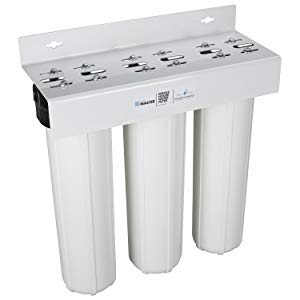
If staining is a problem, this Home Master three-stage filtration system may be the solution. For use with non-chlorinated well water only.
It’s three sequential filters remove sediment and chemicals down to a single micron — plus minerals like iron and manganese that can stain your clothing, dishes and bathroom fixtures and cause costly damage to plumbing and water-using appliances.
Features
- Quality construction
- Helps extends the life of appliances
- Odorless water
- Crystal clear water
- Eliminates brown/reddish stains
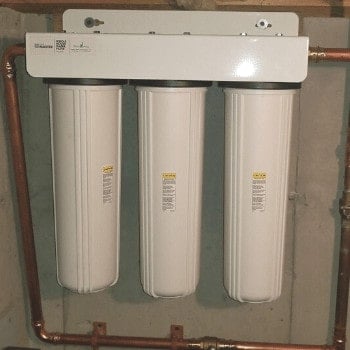
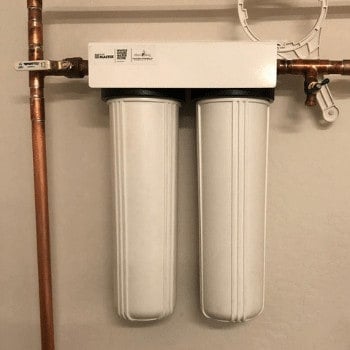

Best For: This whole house water filter system has a great price for its capability, and while the replacement filters appear to cost more than those for similar models, my research shows they last longer and do a better job.
Not best for: Anyone looking to eliminate harmful well bacteria and microbial cysts.
Pros:
- Designed for easy DIY installation, the kit complete with everything you need including cartridge filters.
- Filter changes are also less frequent than previous models reviewed.
- Home Master’s 3-stage multi granulated activated carbon block filter reduces odors and reduces Iron at 3ppm.
- Sediment filter removes dirt, rust, VOC’s down to 1-micron
- Eliminates stains on tubs and sinks
- Improved water flow
Cons
- Higher-than-average replacement filter cost
- Not for use with municipal or chlorinated well water
Home Master 3-stage Product Updates:
- Extended filter life with Home Master’s updated GAC carbon water filter tech and improved kdf filtration media.
Read our full review: Home Master 3-stage Review
#7 SpringWell WS — Best System For Well Water
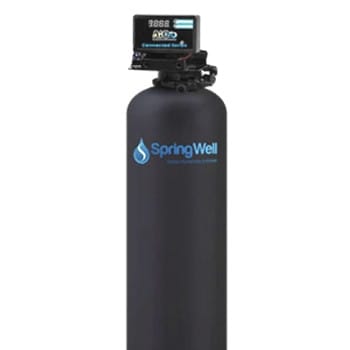
If your well water has been letting you down and you’re tired of scrubbing the reddish/brown stains from your sink or tub — then you’re in luck.
Let me introduce you to the Springwell WS whole house water filter system that’s beats the competition when it comes to removing Iron, manganese, and hydrogen sulfide up to 8PPM.
Features
- User-friendly digital interface
- Control with a mobile app
- Low-Maintenance
- NSF Certified components
- 90- day Satisfaction guaranteed
- Lifetime warranty
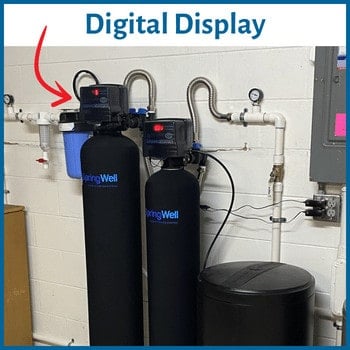


Best for: Those looking for the best overall filtration for well water at a great price.
Not best for: If you’re on a budget, I would look to another system like Home-masters 3 stage system as it has similar features.
Pros
- Won’t reduce water pressure one bit – and no other whole house water filter system comes close!
- This system can be installed outside permitting your region doesn’t go below 36 degrees.
- We love the fact that this system doesn’t strip out the beneficial minerals that many well owners have come to love and rely on.
- We also love that this system is easy to use and operate from our mobile phones that we can just simply forget about it, until we get a notification on when to change filters.
- Springwell didn’t hold back when engineering this system for complete control and ease of use when they created a simple to use app to monitor your system on the go.
- Quickly glance at your systems performance with their digital system display.
- Enjoy seeing virtually no iron/reddish stains on your sink, toilet and tub!
- Easy replacement filter changes.
- Four-stage filtration system
- Automatic backwash tech
- Literally no maintenance – which is a bonus in my opinion.
Cons
- Higher-than-average initial cost

Use Coupon Code: QWL5 to save
SpringWell WS Product Updates:
- SpringWell now offer filtration for 4+ bathrooms
- Optional UV add-on that can eliminate nearly 100% of harmful viruses.
- Optional Reverse osmosis upgrade
Read our full review: Springwell WS1 Review
#8. Home Master HMF2SMGCC 2-Stage System – Best for Tap Water
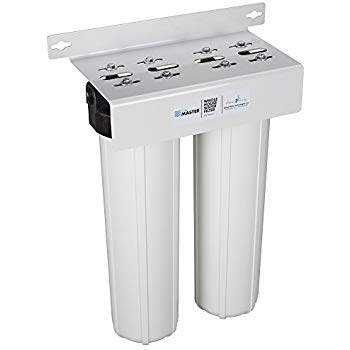
If you use city water and want a water filter that’s a great value, Home Master’s two-stage system costs less than its three-stage cousin but has most of its capability.
Features
- High-grade sediment filter for superior filtration
- Granular activated carbon to reduce chlorine, taste and odor
- KDF85 media to remove heavy metals
- Long-lasting filter cartridges up to 1 year
- Easy installation and maintenance, no waste water

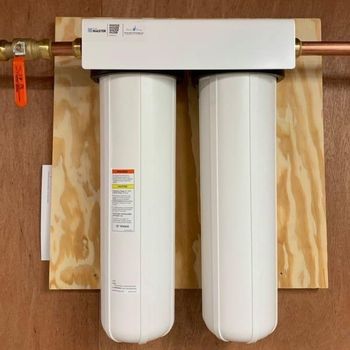

Best for: This system is ideal for households with high levels of sediment, chlorine, taste and odor in their water for a great price.
Not best for: Those looking to remove fluoride, nitrates, or arsenic.
Pros
- It reduces the contaminants most likely to creep into municipal water supplies like lead and industrial chemicals.
- Superior catalytic carbon filters excel at removing chlorine and chloramines that make water taste like it comes from a swimming pool.
- With a 95,000-gallon capacity, this system delivers the freshest tasting water possible to every tap in your home for up to a year for a family of four between cartridge changes.
- Certified to remove up to 95% of sediment, chlorine, and other contaminants from your water.
- Includes a multi-gradient sediment filter and a granular activated carbon filter for superior filtration.
- Features a built-in shutoff valve to prevent water waste during filter changes.
- Easy installation with no electricity or drain required.
- Comes with an extra set of filters for extended use.
Cons
- We find this system expensive compared to other water filtration systems with similar features
- Not suitable for well water
- Requires frequent filter changes
- Does not remove fluoride from the water
Our take
If your goal is to improve the taste of your water without removing beneficial minerals, this filter is an excellent choice. It’s easy to install and maintain, has an excellent reputation for meeting performance claims, and its capacity is enormous. If you use bottled water now, buy this system instead, and you’ll save a small fortune.
#9. 3M Aqua-Pure Whole House Water Filtration System
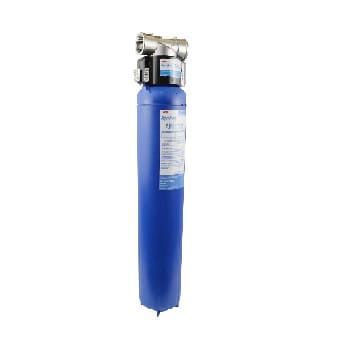
Like Aquasana’s EQ-1000, 3M’s Aqua-Pure AP904 also features a scale inhibition system that protects pipes and appliances.
Its carbon filter captures sediment down to five microns — smaller than a red blood cell, and it can capably reduce the taste of chlorine.
Features
- Reduces sediment, chlorine taste and odor, rust, dirt and other contaminants from your home’s water supply.
- Easy to install and includes a bypass valve for easy maintenance without having to shut off the water supply.
- Compatible with most existing plumbing systems.
- Includes a pressure relief valve for added safety and protection.
- Designed for long-lasting performance and reliability.
- NSF certified.
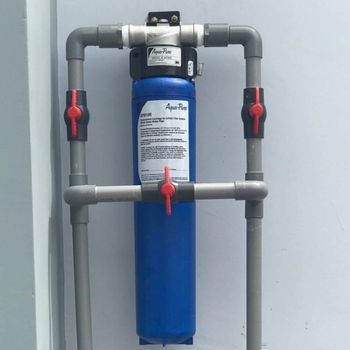
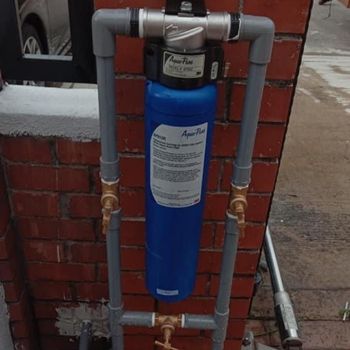
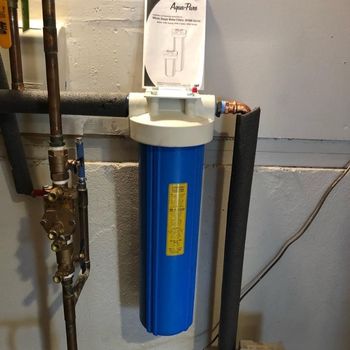
Best for: For households that want to reduce basic tap water contaminants and improve the taste of their drinking water for a budget friendly price.
Not best for: This filter isn’t good for those on well water as it can’t handle heavy well sediment.
Pros
- Its capacity is 100,000-gallons — a tenth of the EQ-1000 — and it doesn’t remove heavy metal or chemical contaminants
- If you don’t need that capability, it’s among the most economical filters on the market.
- This filter is great for a family of four and should last you about a year before needing to replace the filter.
- If your sediment levels are very high, it may need to be changed sooner.
- Do-it-yourself installation is a cinch and won’t compromise the warranty.
- Maintenance is as simple as an annual cartridge change.
Cons
- Not suitable for areas with hard water.
- May not remove all contaminants from the water.
- Doesn’t work very well with well water due to sediment.
Our take
Simplicity defines this filter. Both installation and cartridge changes are a snap. Water flow is generous and with one annual filter change, you can set it and forget it. It works with city water and protects your plumbing, but it’s mostly just a high-quality filter with softening capability.
It doesn’t remove heavy metals, chemicals, and it won’t make water potable, but if you don’t need that, why pay for it? Sometimes, simple is best.
#10. iSpring WGB22B 2-Stage 20-Inch Big Blue Whole House – Best Value
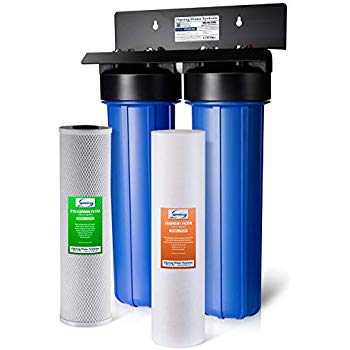
Like Home Master’s HMF2SMGCC 2-Stage System, this water filter from iSpring protects your family from a range of possible water contaminants including agricultural and industrial solvents, chemicals and VOCs, and its carbon block technology effectively reduces the taste of chlorine.
Features
- 2-stage filtration system for whole house water purification
- 20-inch filter housing with 1″ inlet/outlet ports
- Includes two filters one GAC (Granular Activated Carbon) filter and one for sediment
- Removes dirt, rust, sand, silt, sediment and other impurities from your water
- Reduces chlorine taste and odor, as well as other contaminants
- Simple installation and easy filter replacement
- Durable construction for long-lasting performance

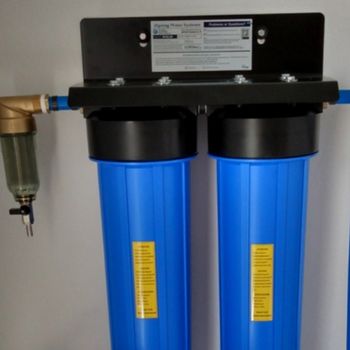
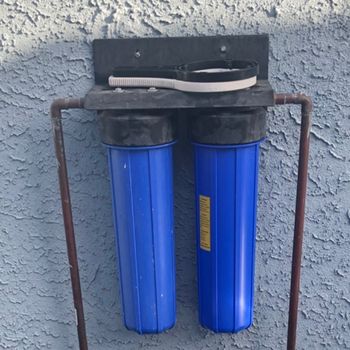
Best for: a family of four that needs a low-cost, NSF certified system that doesn’t impact flow-rates.
Not best for: anyone with heavy chlorinated tap water or has concerns of lead.
Pros
- It has a similar 100,000-gallon total capacity and an even higher 15 GPM flow rate.
- It doesn’t remove lead, so if that’s your goal, you’ll need the WGB22B-PB version of this system, but if it’s not an issue.
- This unit will meet your needs for about 30-percent less than the Home Master. It’s a top value.
- It’s designed to be DIY-friendly but basic plumbing skills help.
- We really like that both replacement filters can be replaced at the same time — about once a year.
Cons
- Doesn’t reduce lead
- Not ideal for heavily chlorinated water
Our take
This system doesn’t remove lead. That’s a significant drawback if you want a water filter for peace of mind but don’t know what’s in your water. If you’re confident your water is lead-free, the WGB22B is a superb value. Your water will taste great, and it’s an
#11. Express 3-Stage Home Water Filtration System
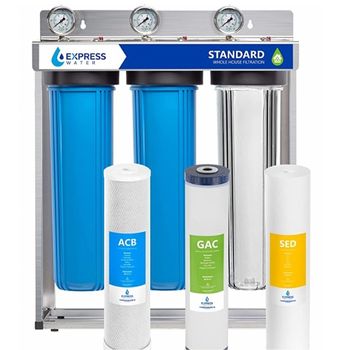
If you don’t like guesswork, you’re going to love this 3-stage filter from Express. Like similar filters from iSpring and Home Master, it uses a high-density polypropylene sediment filter to catch dirt and rust.
Plus it features two long-life carbon filters — one granular and one carbon block — to remove contaminants including chemicals, pharmaceuticals and chlorine.
Features
- Integrated pressure gauges
- One-year warranty with free lifetime technical support
- Made with all food-grade materials
- NSF/ANSI-certified
- Quick, clean filter changes
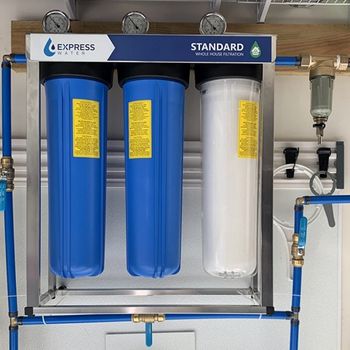
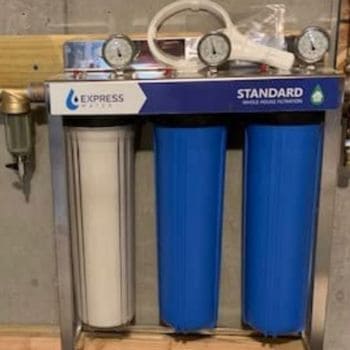
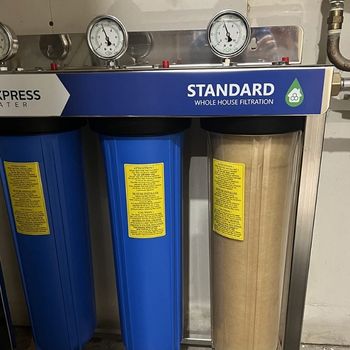
Best for: for a family of 5 looking for a great mid-range whole home filter system at a great price.
Not best for: Families looking to remove lead and heavy metals.
Pros
- It’s stress-free to install with a 100,000-gallon capacity and it’s even easier to maintain.
- What sets it apart is that each filter in the system has a pressure gauge.
- Simply the gauges to easily determine when filters need to be changed for guess-free maintenance.
- This filter system can be used with well water, but won’t make water potable or remove heavy metals.
- Compact design that fits easily in small spaces
- Affordable price point compared to similar systems
Cons
- Doesn’t remove heavy metals including lead.
- It’s on the pricey for filter replacements.
Our take
Express is a newcomer in the whole house water filter market, but this product is particularly well-built. It’s a few dollars more than it’s competitors, but it feels solid. You’ll want to be sure your water is lead-free before using this system, especially if you have kids, but it does what it says it’ll do, and it does it well.
The gauges help guide cartridge changes, and the system comes with lifetime technical support. I recommend it for nervous first-time filter buyers.
Comparison Table
(Mobile users: Swipe to scroll) Compare Brands & Models
Compare Brands & Models
|
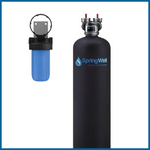 #1 SpringWell CF City Water
#1 SpringWell CF City Water |
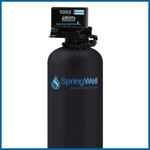 #2 SpringWell WS Well System
#2 SpringWell WS Well System |
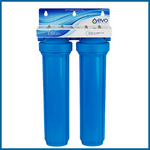 #3 Evo E-1000 Tap Water
#3 Evo E-1000 Tap Water |
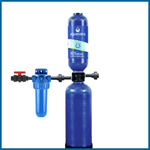 #4 Aquasana’s EQ-1000
#4 Aquasana’s EQ-1000 |
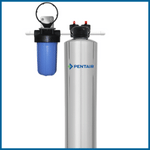 #7 Pentair P600 system
#7 Pentair P600 system |
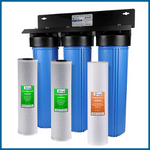 #8 Ispring 3-stage system
#8 Ispring 3-stage system |
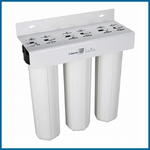 #9 Home Master 3-stage system
#9 Home Master 3-stage system |
|---|---|---|---|---|---|---|---|
| Rating | 5/5 | 5/5 | 4.5/5 | 4.5/5 | 4.5/5 | 4.5/5 | 4.5/5 |
| Price | $$$ | $$$ | $$ | $$ | $$$ | $$ | $$ |
| Contaminants Removed | 10+ | 3 | 10+ | 10+ | 10+ | 10+ | 10+ |
| Filter Type | Catalytic carbon & kdf media + Sediment | Air Injection Oxidation + Sediment | Carbon + Sediment | Carbon + KDF + TAC+ Sediment | Activated Carbon + Sediment | Carbon + Sediment | Carbon + Sediment |
| Capacity | 1M gal. | 1M gal. | 80K gal. | 1M gal | 600,000 gal. | 100,000 gal. | 100K gal. |
| Flow Rate | 9 – 20 GPM | 12 – 20 GPM | 15 GPM | 12 GPM | 15 GPM | 15 GPM | 20 GPM |
| BlueTooth | ✔️ | ✔️ | ❌ | ❌ | ❌ | ❌ | ❌ |
| Annual Cost | ~$40 | ~$40 | $150 – $300 | ~$40 | ~$35 | ~$225 | $235 – $400 |
| Warranty | Lifetime | Lifetime | Lifetime (limited) | 5 years | 5 years | 1 year (limited) | 2 year (limited) |
Didn’t find what you’re looking for? See our other whole house water filter reviews:
Buyer’s Guide
Investing in a whole house water filter doesn’t have to break the bank. You can evaluate your risks and find the best filtration system for your family without sacrificing other expenses.
Peace of mind against the unknown is important, but not all water supplies are prone to the same type of contamination. Make sure you get what you need without overspending.
Let’s look at the most important things to consider when making a purchase decisions.
In this guide, you’ll learn:
- How we chose these systems
- Key considerations
- Choosing the right system for your home
- How to test your water
- System size and footprint
- Frequently asked questions
How We Chose
We understand that it can be an overwhelming process if you’re new to whole home water filtration systems. So we wanted to set your mind at ease and share our selection process, and expertise, in what we feel are top considerations to make before any purchase.
In our selection process, we look at 7 key factors: certifications, contaminant removal, flow-rate, ease of use, maintenance requirements, warranties, and long-term ownership costs. We also take it a step further by speaking with the manufacturers of these brands for information we feel wasn’t covered well enough.
Before any system makes it on our list, we need to dig into online reviews and user feedback. In doing so, this process sometimes would reveal problems for a variety of reasons that our personal testing or research didn’t uncover.
Key Considerations
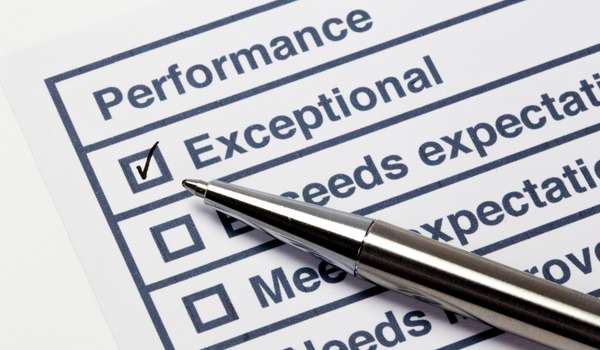
- Contaminant Removal: It’s not just about removal but how efficiently it’s done. Delve into the filter media type, its micron size, and the rate at which contaminants are eliminated.
- Flow Rate: For homes with low water pressure, this is pivotal. Systems vary, but a rate above 7GPM is a solid benchmark.
- Ease of Use: While many brands offer installation guides, the systems we’ve spotlighted are generally user-friendly, even for DIY enthusiasts.
- Maintenance: Some systems have post and pre-filters needing replacement every 6-12 months. It’s a small detail that can impact long-term satisfaction.
- Certifications: The NSF/ANSI logo isn’t just a sticker. It’s a promise that the system lives up to its claims, ensuring you get quality and reliability.
- Warranties: Dive deep into warranty details. Understand the coverage scope and its duration to avoid future surprises.
- Long-term Costs: Beyond the initial price, consider ongoing expenses like parts or service fees. It’s about value over time, not just the present.
Contaminant Reduction Capability
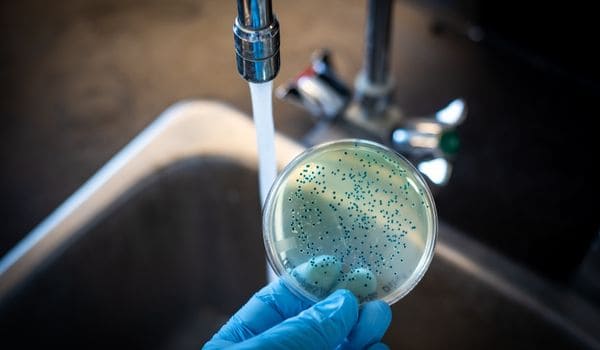
Both city and well water come with their own set of challenges. From lead in aging pipes to chemicals and even pharmaceutical traces, the threats are varied. Additives like fluoride and chloride, while meant for safety, can sometimes be detrimental. And let’s not forget the havoc excessive minerals in hard water can wreak on your pipes and appliances.
Choosing the right filtration system hinges on understanding your water’s quality, and anticipating future risks. The ideal approach? Get to know your water intimately. Available test kits at local hardware stores can be sent to labs for precise results. If you’re on city water, your local water treatment authority can provide insights.
See our top recommended water test kits.
System Type and Footprint
Whole house water filters are just as effective as point-of-use systems, but they provide larger capacity and require installation near the water entry point.
Make sure to measure the area beforehand and compare filter dimensions before purchasing.
Capacity
| Brand | Capacity | Flow Rate |
|---|---|---|
| Springwell | 1,000,000 Gallons | Up-to 20 GPM |
| Aquasanna EQ | 1,000,000 Gallons | 7 GPM |
| Pentair P600 | 600,000 Gallons | 10 GPM |
| Ispring WGB32B | 100,000 gallons | 7 GPM |
| 3M Aqua-Pure | 100,000 gallons | 10 GPM |
Filter capacity determines how many gallons a filter can process before needing to be changed. Always check the system’s total filter capacity – some have multiple filters with different change intervals. The higher the capacity, the less maintenance is needed for your whole house water filter.
Flow Rate
| Fixtures & Appliances | Flow-rate (GPM) |
|---|---|
| Dishwasher | 1-3 GPM |
| Washing Machine | 3-5 GPM |
| Shower | 2-5 GPM |
| Toilet | 2-3 GPM |
| Faucet | 2-4 GPM |
Flow rate is a measure of how swiftly a filter can process water. On average, simultaneous household activities, like taking a shower while flushing a toilet, demand around 6 GPM.
It’s worth noting that there’s a trade-off: a filter that removes more contaminants will typically have a reduced flow rate. For instance, the Aquasana EQ-1000 offers thorough filtration at a 7 GPM rate, whereas the Home Master’s HMF2SMGCC 2-Stage System boasts a faster 15 GPM.
Determining Your Home’s Water Flow Rate
You might not be aware of this important detail. However, it’s very important to know what your “effective flow-rate is” so that you can purchase the right size whole home filtration system for your needs so that you don’t buy an under-performing system.
Here’s a simple method to gauge your flow rate:
- Ensure all indoor water faucets are turned off.
- Take a 5-gallon bucket and position it under your water spigot.
- Start filling the bucket, simultaneously setting a timer to track the fill duration.
- As a reference: If it takes roughly 60 seconds to fill the bucket, your flow rate is approximately 5 GPM.
| Seconds To Fill 5 Gallon Bucket | Water Flow Rate | Seconds To Fill 5 Gallon Bucket | Water Flow Rate |
|---|---|---|---|
| 76-100 | 3 GPM | 61-75 | 4 GPM |
| 51-60 | 5 GPM | 43-50 | 6 GPM |
| 38-42 | 7 GPM | 34-37 | 8 GPM |
| 31-33 | 9 GPM | 28-30 | 10 GPM |
| 26-27 | 11 GPM | 24-25 | 12 GPM |
| 22-23 | 13 GPM | 21 | 14 GPM |
| 20 | 15 GPM | 19 | 16 GPM |
| 18 | 17 GPM | 17 | 18 GPM |
| 16 | 19 GPM | 15 | 20 GPM |
| 14 | 21 GPM | 13 | 22 GPM |
| 12 | 23 GPM | 11 | 24 GPM |
| 10 | 25 GPM |
Understanding Micron Ratings
The micron rating of a water filtration system is a pivotal factor in your selection process. It signifies the particle size that the system can effectively filter out, with common ratings spanning from 0.5 to 50 microns.
- For robust protection against minuscule contaminants like bacteria or viruses, filters with a low micron rating (0.5-10) are ideal.
- If your primary concern is filtering out larger debris like sand or silt, a filter with a higher micron rating (20-50) is more appropriate.
It’s worth noting that opting for a very low micron rating might lead to water pressure challenges. This is a key reason why whole house reverse osmosis systems aren’t as prevalent in the market.
NSF Standards for Water Filters
While the federal government doesn’t directly regulate water filters, the industry has established its own benchmarks. NSF International, in collaboration with the American National Standards Institute (ANSI), has set voluntary standards for performance and safety.
Here’s a breakdown of key NSF certifications:
- NSF 42: Targets taste and odor impurities.
- NSF 44: Focuses on softening water by eliminating hard minerals through ion exchange.
- NSF 53: Addresses contaminants known to impact health.
- NSF 55: Uses ultraviolet light to neutralize bacteria, viruses, and cysts.
- NSF 58: Aims to reduce contaminants regulated by the EPA using reverse osmosis.
- NSF 401: Highlights the reduction of specific emerging contaminants, like PFOA and certain pharmaceuticals, not yet under regulation.
NSF/ANSI certifications are often viewed as a hallmark of quality. Companies that invest in these certifications typically prioritize transparency regarding their filter’s efficacy. However, while certifications are valuable, it’s essential to also weigh other aspects, such as the quality of filter materials.
In essence, certified filters offer an additional layer of confidence as they are regularly tested for quality control, so no one gets a “bad batch” of water filters. All things being equal, certifications are an added boost of assurance.
Read our guide on what NSF is Exactly.
Deciphering Filter Lifespan
| Brand | Media Change/ Replacement: | Cost |
|---|---|---|
| Springwell CF1 | 10 years or 1,000,000 gallons | $335.00 |
| Aquasanna EQ 1000 | 10 years or 1,000,000 gallons | $849.00 |
| Pentair P600 | 5-years or 600,000 Gallons | $376.00 |
| Ispring WGB32B | 1-year or 100,000 gallons | 149.99 |
| 3M Aqua-Pure | 1 year or 100,000 gallons | $190.00 |
Filters have a finite lifespan and must be replaced on time to ensure optimal water quality. Sediment and carbon filters typically last 3-9 months, however, extra capacity filters can last longer, with reverse osmosis membranes lasting 2-5 years.
When considering the cost of a whole home filtration system always factor in the price of replacement filters, as cheaper cartridges need to be changed more often. Invest in better filters for longer-lasting filtration and less maintenance.
Understanding the Costs

While the initial price tags on our listed water filters may catch your eye, it’s the long-term costs that truly matter. Beyond the upfront cost, think about filter replacements and their frequency. Some systems, while cheaper initially, might end up costing more in the long run due to frequent maintenance. It’s a balance worth weighing.
| System Type | Average Cost |
|---|---|
| Whole House Filtration System | 750.00 to $3,500+ |
| Well Water Filtration System | 750.00 to $3,500+ |
| Reverse Osmosis Systems | $500.00 to $8,000+ |
| UV Disinfection System | $600.00 to $1200+ |
Professional Installation: What to Expect
Installation costs can vary based on your location and the complexity of the job. Many plumbers operate on a minimum 4-hour charge, regardless of whether the installation takes one hour or the full four. The table below offers a ballpark figure for installation costs, but remember, these estimates don’t account for potential additional expenses like extra piping.
For a deeper dive into costs, check out our detailed guide: How Much Do Whole House Water Filter Systems Cost?
| System Type | Labor | Average Installation Cost |
|---|---|---|
| Whole House Filtration System | 4 to 8 hours | $500 to $1200+ |
| Well Filtration System | 4 to 8 hours | $500 to $1200+ |
| Reverse Osmosis System | 4 to 8 hours | $500 to $1200+ |
| UV Disinfection System | 4 hours or less | $350 to $600 |
| 3M Aqua-Pure | 4 hours or less | $350 to $600 |
Before You Buy
Maximizing Value: Know What You’re Filtering
Understanding the contaminants in your water is the first step to ensuring you get the best value from your filtration system.
City Water Concerns: While city water undergoes disinfection and is generally safe to drink, it can still contain various contaminants. Despite EPA regulations, you might find:
- Common additives: Fluoride, Chlorine, Chloramine
- Byproducts & chemicals: Bromate, Haloacetic acid, Herbicides, Pesticides, PFOA/PFOS, Industrial solvents, Volatile organic compounds
- Physical impurities: Sediment, Trace pharmaceuticals
- Potential intruders: Lead, bacteria, and parasitic cysts, especially from deteriorating underground pipes.
Well Water Woes: For those relying on well water, while you don’t have to worry about added fluoride or disinfectants, there are other concerns. An estimated 20% of U.S. wells might be contaminated with:
- Natural impurities: Sediment, Hard minerals, Lead, Arsenic, Mercury, Chromium
- Chemical residues: Nitrates, Agricultural chemicals, Petroleum products, Industrial chemicals
- Biological threats: Bacteria, parasites, and more.
Being aware of these potential contaminants helps you choose a system that targets your specific needs, ensuring you’re not overpaying for unnecessary filtration.
See our: Best well water filtration system guide
The best way to choose a whole house water filter is to know what’s in your water today. City water users can get a quality report from their treatment authority but should test their tap water for lead separately.
Well owners should do a comprehensive test — DIY or via a certified lab. Regardless of water source, you can then shop confidently for a filter that targets the greatest number of problem contaminants.
Understanding Warranties
Choosing the wrong whole house water filtration system can be a costly mistake. Make sure to read the fine print and choose a company/brand that offers an iron-clad warranty and decent return policy – this way you’ll have peace of mind knowing your investment is protected!
| Filtration Brand | Warranty | Money Back Guarantee |
|---|---|---|
| Springwell | Lifetime | 6-month money back guarantee |
| Aquasanna | 6 years | 90 days |
| Pentair | 650,885 Gallons or 5 years | 60 days |
| Ispring | 1 year | 30 days |
| 3M Aqua-Pure | 5 years | 30 days |
Decoding Money-back Guarantees
While trial periods offer a glimpse into a product’s performance, it’s essential to be aware of the associated terms and conditions. Here’s what to keep in mind:
- Duration: Opt for trial periods that suit your needs, whether it’s 30, 60, or 90 days.
- Hidden Costs: Be cautious of restocking fees. Additionally, the size and weight of the product can influence return shipping costs, which typically fall on the buyer.
Unraveling the “Lifetime Limited Warranty”
The term “lifetime” can be misleading. Before committing:
- Read the Fine Print: Understand what “lifetime” covers. It might only pertain to specific parts, like tanks, while excluding others such as fittings and valves.
- Company’s Intent: A limited scope in warranty doesn’t reflect the company’s quality. It’s more about their coverage strategy.
Optimizing Your Filtration Investment
Understanding your water’s specific needs is crucial. While the unknowns in your water can be concerning, many households benefit from targeted filtration. Here’s what to consider:
- Emergencies: Unless faced with a significant water main issue or disaster, comprehensive virus elimination systems might be an overkill.
- Water Hardness: If your water isn’t hard, you might not need softening features.
Prioritize essential filtration based on your water’s profile. If your budget allows, then consider broader filtration for added peace of mind.
Whole House Filtration vs. Reverse Osmosis: Making the Right Choice
Whole House Filtration:
- Comprehensive Coverage: These systems, positioned near your home’s water entry point, ensure every drop—whether for drinking, cooking, or bathing—is treated.
- Efficient Filtration: Leveraging multi-stage processes with sediment, carbon, and KDF filters, they effectively eliminate contaminants like dirt, rust, and chemicals. The result? Clean, odor-free, and tasty water without compromising water pressure.
Reverse Osmosis (RO):
- Precision Filtration: RO systems, especially under-sink variants, are designed for meticulous purification. Using an RO membrane, they can filter out even the minutest particles.
- Limitations: While they offer superior water quality, RO systems can be slower and have a limited daily filtration capacity.
- Targeted Filtration: They excel in removing specific toxins, like fluoride, which some traditional filters might overlook. This makes them ideal for areas with high contamination.
Value Proposition: Given the comparable pricing, opting for a whole house filter might offer better value, especially if it addresses your primary water concerns and ensures comprehensive treatment.
Filter Cartridges
Choosing the right filter cartridge can be a puzzle, especially when performance ratings often reflect average water conditions. Here’s what to keep in mind:
- Claims vs. Reality: A filter might boast a 95% lead reduction, but its efficacy can fluctuate based on your water’s unique composition.
- The Role of Additional Media: Some cartridges come with extra media layers, enhancing filtration. For instance, sediment pre-filters tackle larger contaminants, preventing clogs and boosting the lifespan and efficiency of subsequent filters.
- Reading Between the Lines: When a filter promises to remove contaminants “up to” a certain percentage, it’s essential to remember that the actual removal rate could range anywhere from 0% to the maximum percentage, contingent on your water’s quality. While specifications offer insights, they aren’t absolute guarantees.
- Notable Mentions: Systems like Express Water Whole House and iSpring WGB32B feature sediment pre-filters, ensuring larger particles don’t hinder the performance of other filters in the lineup.
| Brand | Filter | Annual Cost |
|---|---|---|
| Springwell | 5 Micron filter | ~$40.00 |
| Aquasanna EQ | Pre Filter & Post Filter | $120.00 |
| Pentair P600 | 5 Micron filter | $70.00 |
| Ispring WGB32B | filter cartridges | $75.00 |
| 3M Aqua-Pure | Filter Cartridge | $127.00 |
Learn more about filtration cartridge types and sizes.
Softening Capability
No filter on our list is an actual water softener, but two have some softening capability that protects appliances. The Aquasana EQ-1000, the Home Master HMF3SDGFEC 3-Stage System have some variation on technology that doesn’t remove minerals, but it prevents them from building up on pipe walls.
It won’t alleviate the other effects of hard water, but in place of adding a separate water softener, it’s a plus.
Pros & Cons to Consider
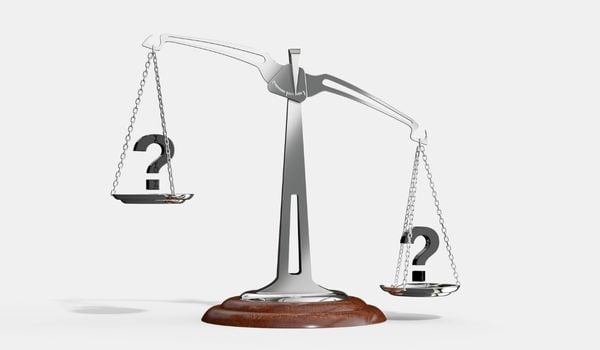
Pros:
- Pristine Water: Experience the luxury of clean, purified drinking water in every corner of your home.
- Comprehensive Filtration: These systems are tailored to eliminate chlorine, chemicals, and other contaminants commonly found in municipal water supplies.
- Combat Sediment: Minimize sediment accumulation in your pipes and fixtures, reducing the risk of clogs and maintaining consistent water flow.
- Cost Efficiency: In the long run, a whole house system can be more economical than constantly buying bottled water or equipping each faucet with individual filters.
Cons:
- Maintenance Commitment: These systems demand regular upkeep and timely filter replacements to function at their best.
- Initial Investment: The upfront cost, especially for installation, can be steeper compared to standalone filters due to the system’s expansive nature and intricate setup.
- Not All-Powerful: While effective, they might not eradicate every single contaminant. It’s crucial to research and select a system that aligns with your specific water quality needs.
Installation & Maintenance
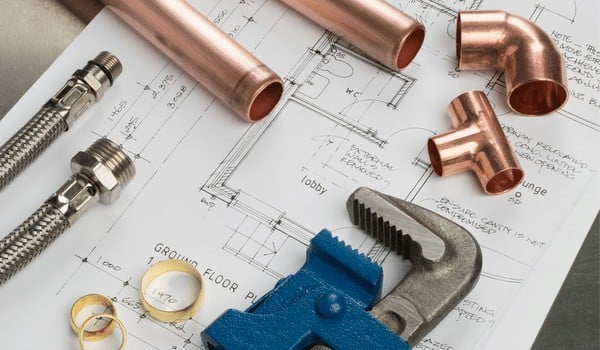
Installation Steps:
- Preparation: Begin by turning off your home’s main water supply. Identify a suitable location for the filter system, preferably near the main water line or an easily accessible spot for future maintenance.
- Valve Installation: Set up shut-off valves on both sides of the intended installation point. This allows for isolation during maintenance.
- Tubing Connections: Securely attach flexible tubing to both sides of the shut-off valves, ensuring no leaks.
- System Integration: Connect one tubing end to the filter system’s outlet port. Then, link it to a T-fitting. Another tubing length should connect back to your main water line.
- Drainage Setup: From the T-fitting, run another tubing length to an additional shut-off valve. This should lead directly to a drain, facilitating the exit of unfiltered water.
- Cartridge Insertion: Place the filter cartridges into their housing. Ensure a snug fit and verify all connections for leaks.
- System Activation: Restore the main water supply. Check for any leaks and assess the water pressure and flow rate.
- Enjoy: Once everything’s in order, activate the system’s shut-off valves. Relish the purified water flowing throughout your home!
Maintenance Tips for Optimal Performance:
Tank-based units shine with their minimal maintenance needs, primarily involving periodic sediment filter replacements. Conversely, cartridge-based systems demand more frequent filter changes, as per the manufacturer’s guidelines.
- Filter Replacement: Every 3-6 months, replace your filter. Always refer to the manufacturer’s guidelines, as water quality can influence replacement frequency.
- Housing Cleanliness: Periodically, detach the housing unit from its bracket and give it a warm rinse. This helps eliminate accumulated dirt or debris.
- System Inspection: Regularly check the system’s components. Ensure all connections are tight, and watch out for signs of corrosion or wear.
- Pressure Checks: Annually, test the incoming water pressure using a gauge. Aim for a range between 40-60 psi. If it’s off, seek a plumber’s expertise for adjustments.
- Sediment Flushing: Sediment can accumulate in pipes over time, affecting flow and causing blockages. Every 6 months, use tools like a garden hose or a backwashing valve to clear this buildup.
- Leak Surveillance: Routinely inspect the system’s fittings and connections. If you spot any leaks or drips, get them fixed promptly by a professional.
- Water Quality Monitoring: Consistently test your water to ensure it’s contaminant-free and adheres to safety standards. If discrepancies arise, consult a plumber for filter adjustments.
Frequently Asked Questions
A whole house water filter is only necessary when the water is not safe to drink. However, many non-harmful impurities make the water unpleasant to taste or cook with; thus people often opt for filters to improve its flavor rather than safety.
Yes, they are! Invest in a whole home water filter if your kids don’t enjoy drinking tap water. Hydration is important and filters are usually cheaper than bottled water and healthier than sugary soft drinks.
A whole house Reverse Osmosis filtration system is costly but would remove the most organic molecules, viruses, and particles as small as 0.0001 microns. Traditional under sink reverse osmosis filtration tank media is more suitable for residential use.
Depending on your filtration type, a sediment pre-filter should be changed every 3 to 6 months. A Carbon filter every 12 Months and a post-filter every 12 months.
This entirely depends on the water filtration system you choose. Tank-based filtration media can last up to 10 years or 1 million gallons. Whereas, cartridge based systems can last up to 12 months.
 127 people found this helpful. Was this guide helpful to you?
127 people found this helpful. Was this guide helpful to you? 
